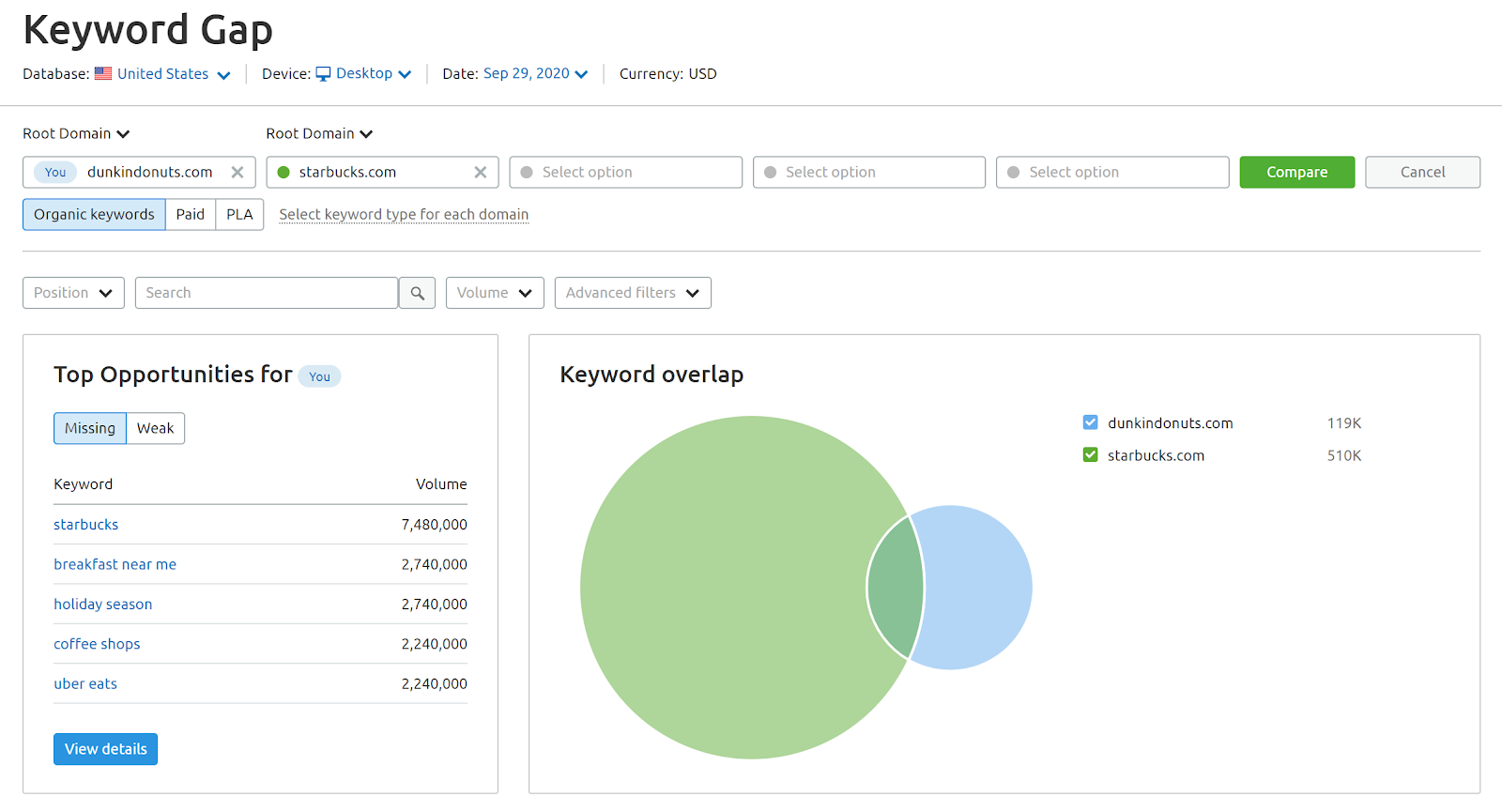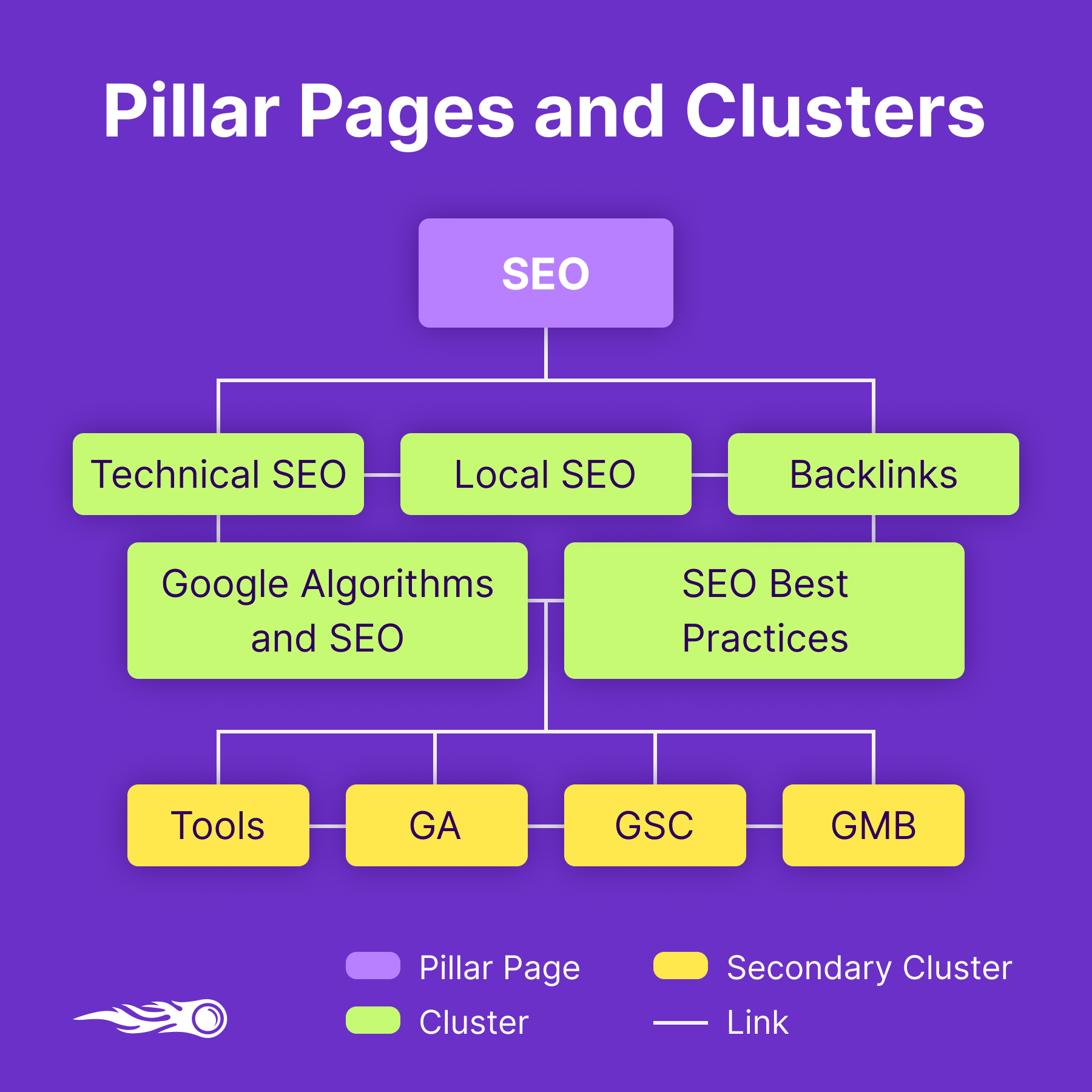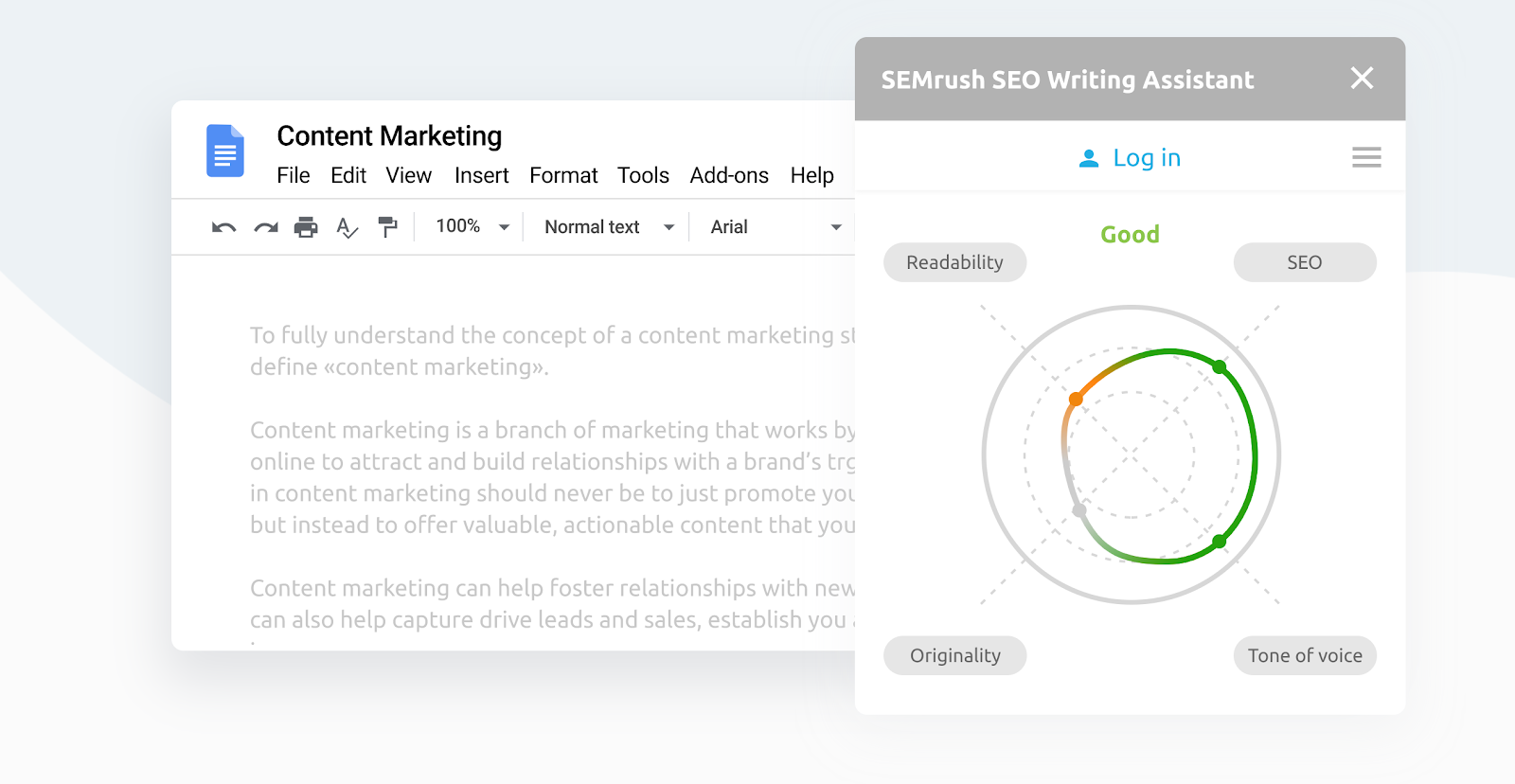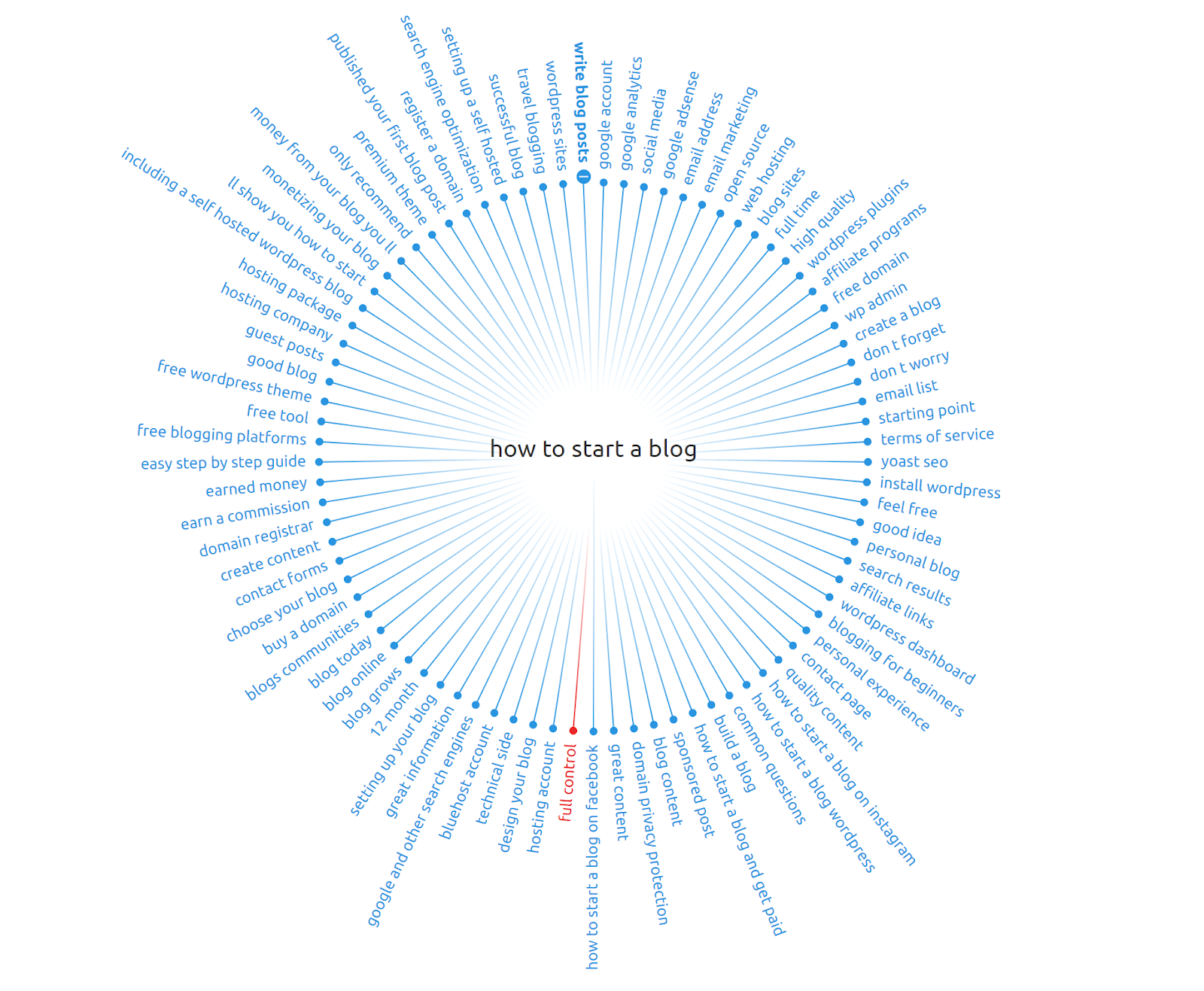If you're in the process of developing your content strategy, you need to determine how to divide and conquer your plan. As we have discussed in past posts, you should be creating clusters related to one key topic, developing a pillar page for that topic, and then subpages.
When content writers structure their content this way, with pillar pages and topic clusters to attract organic web traffic, you have a more organized approach to content creation. In this guide, we’ll cover the basics of topic clusters and how including them in your content structures can improve your marketing strategy.
What Are Topic Clusters?
At the heart of a content cluster strategy is strategic internal linking. Topic clusters are a group of content that revolves around a central topic and use a pillar page to link to and from. In short, topic clusters are centered around a single topic and offer multiple internal linking opportunities to keep readers on your site.
Your content cluster should start with a robust pillar page and then include links to all-related topic cluster pages. More specifically, this breakdown looks like:
Pillar. Your hub for a specific topic. Pillar pages are generally broad and link to multiple topic cluster pages.
Topic cluster. A more in-depth page that answers a specific question about your broad topic and links back to the main pillar page.
Following the topic cluster model has many benefits, including:
More organized content. Pillar pages allow your organization to organize your content. Pillar pages are designed to organize your blog around topic cluster pages.
Improved SEO. Linking topic cluster pages to pillar pages will eventually improve your SEO by giving your blog authority over a particular topic.
Increased content production speed. Once you’ve done the bulk of the work creating a pillar page, topic cluster pages are much simpler to create since the research you do will apply to all of your content.
More comprehensive content. Avoid an overlap or gaps in your content. For example, if you are writing about financing higher education and mention student loans on your pillar page, the cluster pages can include loan types or scholarship opportunities. In this way, your original blog will not go too in-depth on these topics.
How to Create Topic Clusters
The pillar-topic cluster model enables organizations to streamline their content creation and produce better content in less time. The goal of clustering your content goes beyond traditional SEO strategies to help you create quality information. Your content should be planned, researched, and delivered in multiple content formats.
Regardless of your organization’s industry, you can boost your digital media marketing efforts by delivering thoroughly thought-out content. In this next section, we’ll cover the steps you will need to create topic clusters.
Step 1: Decide On Your Core Topic
To begin, you should start by deciding on the core topic. Whether your business publishes blogs about health and well-being or computer software, you can use this strategy to create a curated topic plan. Whatever topic you choose, they should fit into topics that are core to your business. In doing so, you showcase the value that your business can provide to potential clients.
This step is essential, as it will be used to create your pillar page. From there, the content can be broken down into subtopics, which form your topic cluster pages. For example, if your business provides student loans, you might consider a pillar page that discusses the need for student loans and other options for paying for higher education. Your cluster pages should then break down into the fine details of student loan options that your business provides.
Coming up with content ideas requires brainstorming. Start brainstorming your topic cluster ideas around what fits into your business. Working with team members to generate ideas for your content can be an effective way to develop relevant topic ideas. From there, list all of your ideas as they start popping into your head.
Sometimes, brainstorming can feel daunting. Try not to put too much pressure on yourself and instead consider these tips:
Using a sheet of paper, whiteboard, or whatever tools you have at hand, place the central topic in the center. Then, surround that topic with other ideas. Once you have the initial starting points, draw lines from the main topics, and create supporting subtopics.
Compile content that you find helpful. Looking at what others in your industry have posted can help you determine what is missing or can be improved. Using websites like Pinterest or even Google Sheets can be a great place to collect your ideas.
Take a break from brainstorming by going on a walk. Some of the best ideas come in low-pressure environments.
Once you have general topic ideas, consider how they can be used to develop quality content. When choosing topics for your content, it’s important to keep in mind your business’s goals so that your content can reflect that.
Consider these questions to ensure that your topic options reflect your team’s goals:
What does my audience want to know?
Can I build from this topic?
Am I able to break this topic into smaller topics?
Are there other variations of this topic that I can use to develop more posts?
Will I need to explain one key topic before moving to the next? For instance, will someone need to understand interest rates before breaking into other loan topics?
Step 2: Perform Keyword Research On Your Core Topic
Next, you will need to research keywords for your topic. Before you begin researching your topics and writing them, you will need to make sure that you’re on the right track with your topics. This is a critical step to ensure that you’re not wasting your time and reap the rewards of creating quality content.
Also, you should see what your competitors are writing about and what makes their content successful. Using our Keyword Gap Tool, you can analyze and identify keywords that your competitors are falling short of. Some additional insights provided by this tool include:
“Missing” keywords, which you are not ranking for but your competitors are
“Weak” keywords, where you’ll find keywords where you’re ranking lower than your competitors
“Strong” keywords, where you have better rankings than your competitors
You can use all of this information together to identify where you can find some fast wins with topic clusters versus where rankings might prove to be more of a marathon and not a sprint.

Step 3: Outline Pillar and Topic Cluster Structure for Core Topic
In addition to researching keywords, you will need to outline pillar and topic clusters. First, you should consider your pillar page, as the topic clusters will link back to it. When outlining the pillar page, you should attempt to cover a broad range of topics while also leaving room for in-depth subtopics.

The topic cluster pages should go a step beyond and cover the fine details of the topic. When creating the outlines for the topic clusters, ensure that you develop relevant topics that can link back to the pillar page.
Your content outlines should be the blueprints of each piece your team will write. This means that your outlines should include the headings and subheadings, targeted word count, lists of keywords (primary, secondary, and related), and references to high-ranking competitors.
Step 4: Produce Content
After combining your topic ideas from the ideation phase, keywords you researched, and outlines, you are ready to produce quality content. To create quality content, you need to make sure that it will engage your target audience. They should want to read about your content topics.
Your competitors are writing about topics similar, if not the same, as yours; you need to develop content that is appealing and stands out. This means that you will have to avoid rewriting what others have written and have unique, authoritative content. Inevitably, you have to reference other articles, but make sure that you are not copying their work and are developing better content than what already exists.
When producing content, consider these tips:
Write naturally: When writing a topic cluster, you shouldn’t need to stuff keywords since you will be covering the topic in-depth.
Focus on quality: By producing quality content, you should hit your target word count. Writing just for the sake of reaching 2,000 words is not enough to have a high ranking.
Improve content: Improve the content you are referencing to write the very best article for your audience. Look at competitor content and see what they might be missing.
Be clear and concise: SEO content focuses on answering the question at hand. This isn’t the time for creative writing. You want to ensure your content answers the question in an easily digestible way no matter who is reading your article.
When you start writing, you can use Semrush’s SEO Writing Assistant to optimize your content easily. Not only does this tool help your SEO copywriting, but it will also help you improve your content’s readability, avoid plagiarism, and make sure you’re using a consistent tone throughout.

Below are some things to think about when drafting your content:
Avoid keyword stuffing. Make sure that you do not overuse keywords too frequently. Their use should feel organic and natural.
Use related keywords. Use keywords that relate to one another and are what your audience expects.
Add alt attributes to images. Make sure to add alt attributes to all of the images on the topic page to ensure they contribute to your content’s SEO.
Check readability. Ensure that your content is readable to your audience. This means you shouldn’t use concepts that your audience is unaware of and avoid long words, sentences, and paragraphs.
Step 5: Publish Content and Add Internal Links to Supporting Topic Clusters
Even after you’ve published content, you still have a bit of work to do. As you develop new content that connects to the pillar page, you will need to add internal links to the supporting topic clusters continually.
Even if the content is ranking well, there is always room for improvement, as you always need to make sure that your content is up to date. Updating content regularly can keep you a step ahead of competitors and boost your content’s relevance in your industry.
How to Measure Topic Cluster Results
Now that you have created quality content, you need to determine how to measure the topic cluster results. As discussed, you can use this data to improve your ranks and the quality of your content. When looking at this data, you should keep in mind that metric tools typically focus on one page's performance instead of a cluster of content.
One of the best ways to see how your content is performing is by using our Traffic Analytics Tool. Using our tool, you can discover insights like number of visits and unique visitors, engagement metrics, and desktop versus mobile traffic ratio to make sure your content is optimized for where your audience is viewing it the most.
Once you discover which clusters had the most success and where they’re being viewed, you can expand those clusters and develop more content. This should minimize the amount of time you have to brainstorm when developing more content, as you will have an idea about what works for your organization.
Use Topic Clusters to Show Authority
Creating robust content requires organization, ensuring that you spend your time and energy writing great content to showcase your industry expertise. Luckily, you can cut back on time by using topic clusters to produce standout content. Finding the right topics can easily be achieved by using the right tools. Semrush’s Topic Research Tool can help you develop engaging content for your audience. The Mind Map Tool helps you visualize a pillar/cluster model for your topic.

Developing quality content is a great way to increase your website’s reach to specific audiences. The analytics you will receive for topic clusters can help your organization hone in on topics that will continue to attract your target audience. Plus, it will ultimately help you reduce the time spent researching new content.
Innovative SEO services
SEO is a patience game; no secret there. We`ll work with you to develop a Search strategy focused on producing increased traffic rankings in as early as 3-months.
A proven Allinclusive. SEO services for measuring, executing, and optimizing for Search Engine success. We say what we do and do what we say.
Our company as Semrush Agency Partner has designed a search engine optimization service that is both ethical and result-driven. We use the latest tools, strategies, and trends to help you move up in the search engines for the right keywords to get noticed by the right audience.
Today, you can schedule a Discovery call with us about your company needs.
Source:





